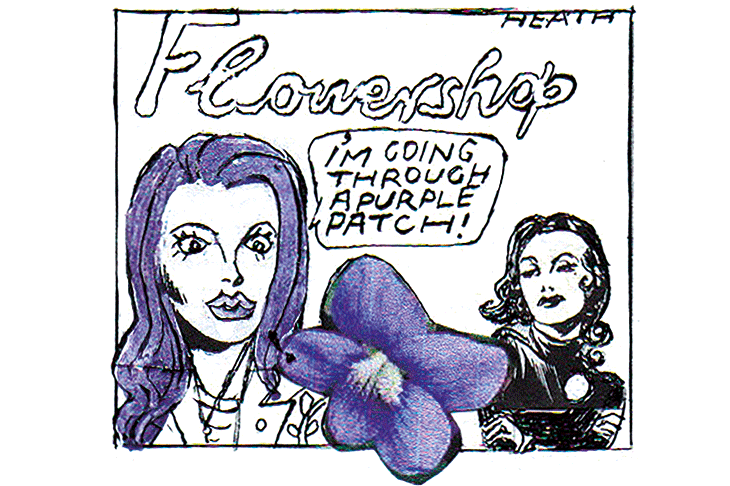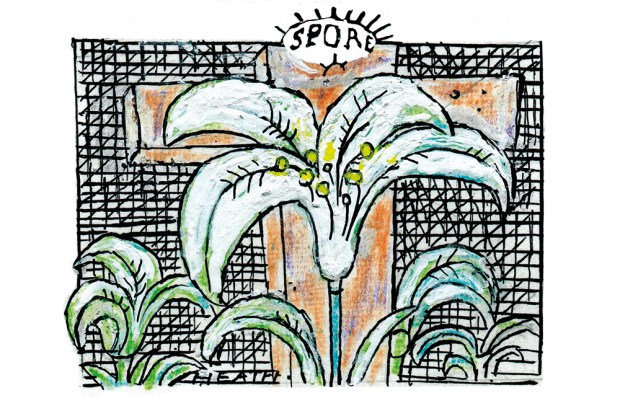The English Rock Garden, the magnum opus of the great gardening writer, horticulturist and plant collector Reginald Farrer, is an indispensable A to Z guide to alpine flowers. When he finally reaches V, Farrer writes: ‘Viola brings this alphabet to the last great dragon in its path.’ But rather than offering fire-breathing terror, he presents a family of flowers containing both beauties and ‘dull and dowdy species’.
There are between 400 and 500 species in the viola family. The sweet violet, while lacking the dark mystery and beauty of its cousin Bowles black, was associated with Aphrodite and became a symbol of both Athens and fertility, which evolved into a Scots tradition of violets being presented to brides on their wedding day in the Athens of the North. The Bonapartes chose the violet as their floral emblem, and it was Empress Marie Louise who established the violet industry in Parma after her separation from Napoleon. They are famously easy to grow and spring up in wild woods, suburban gardens and even terracotta pots from late winter through to early spring in Britain.
One of the most famous literary violas appears in Wordsworth’s poem ‘She Dwelt among the Untrodden Ways’. At the centre of this evasive articulation of grief are the lines where its subject, Lucy, is translated into: ‘A violet by a mossy stone/ Half hidden from the eye!’
Violets come into their own at Easter; purple is, after all, the colour used to symbolise suffering in the Church. It used to be said that these bold flowers grew up straight until the shadow of the Cross fell upon them and caused them to bow their heads in sorrow.
Yet violets are perhaps more readily thought of as a sweeter pleasure. The Viola odorata has been used in kitchens for hundreds of years. In the 18th century, violets would most commonly be found as a dressing for roast veal. American food writer M.F.K. Fisher thought a salad of ‘satiny white endive with large heavily scented Parma violets scattered through it’, that appeared in The Pleasures of the Table by the botanist George Ellwanger, would be ‘the most exquisite dish’. The reality was a disappointment.
The petals can be candied or infused into creams, which are particularly good as chocolates. Fortnum & Mason started selling violet creams in the 1920s. For aficionados of a certain sort of sweet, the flavour of violets reaches its finest expression in the Parma Violet. Named after the violet that is reputed to have the most beautiful scent, this sweet was first produced by British confectioners Swizzels Matlow in 1946. Slightly tragically, a survey by an online sweet retailer found that Parma Violets were the most hated sweet in the country.
If any of those Parma Violet critics were looking for validation for their disdain, they need look no further than Ian Fleming. James Bond’s nemesis Blofeld is revealed, in chapter six of Thunderball, titled ‘The Man with the Violet Breath’, to ‘sweeten his breath’ with ‘violet-scented’ cachous. There is no attempt to hide the derision for such florid deception, though it comes alongside Blofeld’s ‘very beautiful sonorous voice’. But then, as Farrer and Wordsworth saw, violets have always contained both great beauty and something more fearful.
Got something to add? Join the discussion and comment below.
Get 10 issues for just $10
Subscribe to The Spectator Australia today for the next 10 magazine issues, plus full online access, for just $10.
You might disagree with half of it, but you’ll enjoy reading all of it. Try your first month for free, then just $2 a week for the remainder of your first year.














Comments
Don't miss out
Join the conversation with other Spectator Australia readers. Subscribe to leave a comment.
SUBSCRIBEAlready a subscriber? Log in